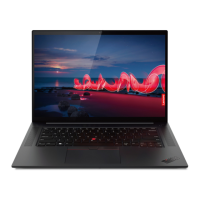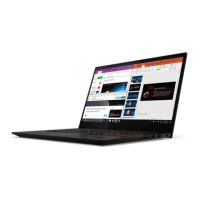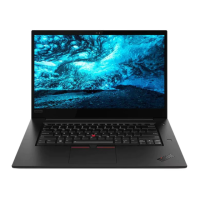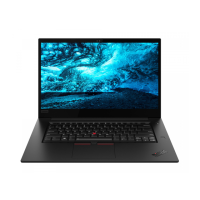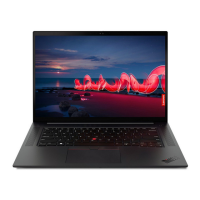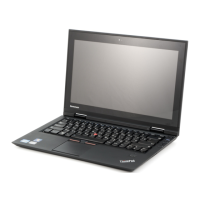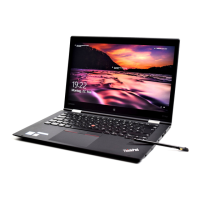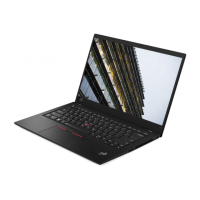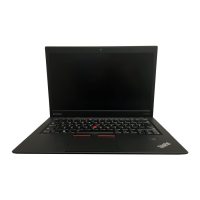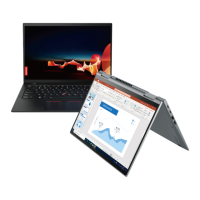
Do you have a question about the Lenovo ThinkPad X1 Extreme Gen3 and is the answer not in the manual?
| RAM | Up to 64 GB DDR4 |
|---|---|
| Storage | Up to 2 TB PCIe SSD |
| Operating System | Windows 10 Pro |
| Battery | 80 Wh |
| Processor | Up to Intel Core i9-10885H |
| Display | 15.6" FHD (1920x1080) IPS / 4K UHD (3840x2160) IPS |
| Graphics | NVIDIA GeForce GTX 1650 Ti |
| Weight | Starting at 1.7 kg / 3.75 lbs |
| Wireless | Wi-Fi 6 (802.11ax) + Bluetooth 5.0 |
| Ports | HDMI 2.0 |
| Dimensions | 14.2 x 9.7 x 0.7 inches (360 x 245 x 17.7 mm) |
Identifies components located on the front panel of the computer.
Identifies components located on the base of the computer.
Details the ports and connectors available on the left side of the computer.
Details the ports and slots available on the right side of the computer.
Identifies components located on the bottom of the computer.
Provides comprehensive details on the computer's technical specifications and features.
Explains actual USB transfer rates based on various system and environmental factors.
Guides on launching applications and accessing settings within the desktop environment.
Instructions for connecting the computer to wired or wireless networks.
How to enable or disable airplane mode and its impact on wireless features.
Describes various methods for navigating and interacting with the computer's interface.
Instructions on how to use the computer's built-in camera.
Details special keys and function key combinations for efficient computer operation.
Explains the usage of the TrackPoint pointing stick and its associated buttons.
Instructions on utilizing the trackpad for pointing, clicking, and scrolling functions.
Describes various multi-finger touch gestures for trackpad interaction.
How to use touch gestures directly on the computer's display screen.
Steps for connecting and configuring an external monitor or projector.
Basic usage instructions for the Lenovo Pen Pro stylus accessory.
Instructions on how to properly store the Lenovo Pen Pro.
Explains the Intelligent Cooling feature and how to switch between performance modes.
Details the P-to-P 2.0 charging function for sharing power between computers.
Steps to successfully pair and connect Bluetooth devices to the computer.
Guide for installing Nvidia proprietary drivers on Fedora operating systems.
Instructions on physically securing the computer using a compatible security cable lock.
Procedure for enrolling and using the fingerprint reader for system login.
Details on various password types (power-on, supervisor) and their management in UEFI BIOS.
Information on setting and using hard disk passwords for data protection.
Procedures for setting, modifying, or deleting UEFI BIOS passwords.
Steps to recover access if the power-on password is forgotten.
Explains the Power Loss Protection (PLP) feature for M.2 solid-state drives.
Introduction to UEFI BIOS and its role in system initialization and configuration.
Instructions on how to access the UEFI BIOS setup utility upon system startup.
Details keyboard shortcuts for navigating and interacting within the UEFI BIOS.
Procedure for modifying the boot device order in the UEFI BIOS settings.
Instructions for setting the computer's system date and time via the BIOS.
Methods for downloading and installing the latest UEFI BIOS update packages.
Lists the Customer Replaceable Units (CRUs) that can be upgraded or replaced.
Essential safety steps to disable the internal battery before component replacement.
General procedures and precautions for replacing Customer Replaceable Units.
Step-by-step instructions for removing and replacing the computer's base cover.
Procedure for the replacement of the wireless WAN card module.
Instructions for safely removing and installing a memory module.
Steps for replacing the M.2 solid-state drive (SSD) in the computer.
Provides answers to common user questions regarding computer operation and settings.
Lists common system error messages and their corresponding solutions.
Explains how to use Lenovo SmartBeep technology to decode computer beep error codes.
Links to product documentation, support websites, and warranty information.
Instructions and guidance on how to contact Lenovo Customer Support for assistance.
Details on how to contact the Lenovo Customer Support Center and available services.
Information on purchasing extended warranties or additional support services.
Guidelines for setting up a comfortable and healthy workspace for computer use.
Advice on maintaining proper posture to prevent discomfort during extended use.
Recommendations for optimal display positioning and brightness settings.
Guidance on maintaining a neutral head and neck position to reduce strain.
Tips for selecting and adjusting a chair to support comfortable working posture.
Recommendations for comfortable arm and hand positioning while typing.
Guidelines for maintaining proper leg and foot positioning.
Ergonomic considerations and tips for using the computer while traveling.
Information regarding display clarity, eye comfort, and visual fatigue.
Explanation of the low blue light feature and its benefits for eye comfort.
How to use the night light software feature to reduce eye strain.
Lists product names, compliance IDs, and machine types for regulatory certification.
Illustrations showing the physical locations of the wireless antenna system.
FCC compliance statement and regulations for the device.
Notice regarding the electronic labeling feature available on the computer.
Contains general legal notices, warranty disclaimers, and licensing information.
Lists registered and unregistered trademarks associated with Lenovo and other entities.
